Towards a Dialect History of the Baggara Belt
Abstract
:1. Introduction
- -
- The phonological reflexes *q > g (k), *ṯ > ṭ (t); *ḏ > ḍ (d) (e.g., *baqar > bagar ‘cows’; *ṯawb >ṭōb ‘women dress’; *kaḏḏāb > kaḍḍāb ‘liar’);
- -
- The presence of the phoneme č (e.g., čalbaq ‘stick.3SG.M’);
- -
- The partial preservation of an etymological a in prepausal position (e.g., gul-t(a) ‘say-1SG/2SG.M’, dagga ‘hit.3SG.M’);
- -
- The generalization of the preformative a- in imperative forms (e.g., a-gīf ‘IMP-stop’);
- -
- The presence of postnominal demonstrative determiners lacking the etymological element *ha- (e.g., da ‘PROX.SG.M’);
- -
- The large use of the lexemes abū ‘father’ and umm/aṃṃ ‘mother’ as compound formatives (e.g., abū gurūn ‘rhino’, aṃṃ garn ‘ground hornbill’);
- -
- The presence of ideophones as a lexical category (aḥmar čall red IDPH ‘bright red’).
“The speech of the Northern Sudan, including Berber Province and the Arabic-speaking parts of Dongola; the speech of the Central Sudan, including Omdurman, the Gezira, and the country to the east of the Blue Nile; the idiom of the Western Sudan, embracing the White Nile, Kordofan and Darfur; and the dialect of the Baggara tribes. It should further be noted that the speech of nomad Arabs everywhere differs from that of the settled population.”
2. The Baggara Belt: Sociohistorical and Linguistic Background
“On the migration of these Arabs from the east there cannot be the least doubt. They advanced gradually through the Negroland. [...] Their dialect is quite different from the Maghrebi, while in many respects it still preserves the purity and the eloquence of the language of Hijaz.”
3. Sample and Sources
- -
- -
- Baguirmi Baggara Arabic (BgA) Walād ‘Ali tribe (Zeltner and Tourneux 1986; Decobert 1985);
- -
- Batḥa Baggara Arabic (BaA), Walād Rashid tribe (Decobert 1985);
- -
- Kordofanian Baggara Arabic (KA), Ḥawāzma and Missiriye tribes (Manfredi 2010, 2013); and
- -
- White Nile Baggara Arabic (WA), Bānu Sulēym tribe (own fieldwork data).
4. Assessing Diatopic Variation across the Baggara Belt
4.1. Phonological Features
- 1.
aṃṃ “mother” vs. ʕamm “paternal uncle” kaṛṛo “cart” vs. karr-o ‘they cooed’ (coo-3PL.M) gaḷb “heart” vs. galab “he came back” (come_back.3SG.M) ḅāḅa “daddy” vs. bāb = a ‘its door’ (door = 3SG.M)
- 2.
- NA-*ḥilim > hilim ‘he dreamt’ (dream.3SG.M), *gaʕad > gaʔad ’he sat down’ (sit.3SG.M)BbA-*ḥille > hille ‘village’, *naʕla > naʔala ’sandal’BaA-ʕud ‘stick’, ḥille ‘village’KA-ḥilim ‘he dreamt’ (dream.3SG.M), gaʕad ‘he sat down’ (sit.SG.M)WA-ḥalla ‘he released’ (release.3SG.M), gaʕad ‘he sat down’ (sit.SG.M)
- 3.
- NA, BbA *aḥmar > ahamar “red”, axḍar > axadar “green”BaA, KA, WA, ShA aḥmar “red”, axḍar “green”
- 4.
- NA *rabaṭ > ṛabaɗ̣ ‘he tied’ (tie.3SG.M),BgA ṭawwal ‘he was late’ (be_late.3SG.M)KA ṭaršān [ɗ̣arša:n], ṭīn ‘mud’WA ṭawwa ‘he lifted’ (lift.3SG.M)
- 5.
- NA *ġādi > qādi ’there’, *šuġul > suqul ’thing’BgA, BaA *ġayyar > ʛɑyyar ‘he changed’ (change.3.SG.M), *šuġul > šuʛul ‘thing’KA *ġanam > qanam [ɠɑnɑm] ‘goats’, *šuġul > šoqol ‘thing’WA *ġanam > ġanam ‘goats’, *šuġul > šuġul ‘thing’
- 6.
- NA ču IDPH, čabaq ‘he waded through’ (wade_through.3SG.M)BgA čat IDPH, čilal ‘milvus’BaB čut IDPH, kolči ‘groundnuts’KA čall IDPH, čorōro ‘topping for sorghum’WA čall IDPH
- 7.
- NA, BgA *šakka > čakka ‘he pierced’ (pierce.3SG.M)KA *šakšāka > čakčāka ‘drizzle’
- 8.
- BaA, BgA *wajh > wiči ‘face’KA *wajh > wičč ‘face’
4.2. Morphosyntactic Features
- 9.
- KA, elision of 1st SG person in absence of nominal objectswiṣílarrive-1SG‘I arrived.’wiṣil-ta kudūgliarrive-1SG Kadugli‘I arrived in Kadugli.’
- 10.
- NA, BgA miné ‘who’/atú ‘which (one)’WA min = ú I’who’ (who = 3SG.M)/yat = ú ‘which (one)’ (which = 3SG.M)KA at = ú ‘who, which (one)’ (which = 3SG.M)
- 11.
- NA, BgA, KA, exceed comparative with fāt ‘pass, surpass’ḥajm = í b = u-fūt = aksize = 1SG IND = 3SG.M-surpass = 2SG.M‘I’m bigger than you.’WA, ShA, elative form with locative markingana akbar min = ak1SG big from = 2SG.M‘I’m bigger than you.’
4.3. Lexical Features
- 12.
- NA, BgA kāka-y ‘(my) grandmother’ (from Kanuri kàká)BgA, KA, WA aṃṃ aṃṃ-í, aṃṃaṃt-í ‘(my maternal) grandmother’ (lit. ‘the mother of my mother’)
- 13.
- NA, BgA čokol ’fork’ (from Hausa cóokàlíi)KA, WA šōka ‘fork’
- 14.
- NA, BgA bilhēn ‘very’; BaA, KA bilḥēn ‘very’
5. Conclusions
Author Contributions
Funding
Institutional Review Board Statement
Informed Consent Statement
Data Availability Statement
Conflicts of Interest
Abbreviations
| - | affix boundary | BaA | Batḥa Baggara Arabic |
| = | clitic boundary | BgA | Baguirmi Baggara Arabic |
| \ | ablaut | ESA | Eastern Sudanic Arabic |
| * | reconstructed form | KA | Kordofanian Baggara Arabic |
| 1, 2, 3 | 1st, 2nd, 3rd person | NA | Nigerian Baggara Arabic |
| F | feminine | ShA | Shukriyya Arabic |
| IDPH | ideophone | WA | White Nile Baggara Arabic |
| M | masculine | WSA | West Sudanic Arabic |
| OBJ | object | ||
| OBL | oblique | ||
| PL | plural | ||
| PROX | proximal | ||
| SG | singular |
| 1. | Among these, we can recall the forms = a 3SG.M, = ki 2SG.F (after both consonant- and vowel-final items) = ku 3PL.M which are also variably found in the sedentary dialects of Chad and western Sudan. |
References
- Abu-Absi, Samir. 1995. Chadian Arabic. München and Newcastle: Lincom Europa. [Google Scholar]
- Behnstedt, Peter, and Manfred Woidich. 1985. Die Ägyptisch-Arabischen Dialekte. Beihefte Zum Tübinger Atlas Des Vorderen Orients. Reihe B, Geisteswissenschaften. Wiesbaden: L. Reichert. [Google Scholar]
- Behnstedt, Peter, and Manfred Woidich. 2011. Wortatlas der arabischen Dialekte, Vol. 1. Leiden: Brill. [Google Scholar]
- Behnstedt, Peter, and Manfred Woidich. 2014. Wortatlas der arabischen Dialekte, Vol. 3. Leiden: Brill. [Google Scholar]
- Behnstedt, Peter. 1998. La frontière orientale des parlers maghrébins en Egypte. In Peuplement et Arabisation au Maghreb Occidental. Dialectologie et Histoire. Edited by Jordi Aguadé, Patrice Cressier and Angeles Vicente. Madrid-Zaragoza: Casa de Velázquez, pp. 85–96. [Google Scholar]
- Behnstedt, Peter. 2016. The niktib-niktibu issue revisited. Wiener Zeitschrift für die Kunde des Morgenlandes 106: 21–36. [Google Scholar]
- Bergman, Elisabeth M. 2002. Spoken Sudanese Arabic: Grammar, Dialogues, and Glossary. Washington: Dunwoody Press. [Google Scholar]
- Blanc, Haim. 1971. Arabic. In Linguistics in Sub-Saharan Africa. Edited by Jack Berry and Thomas Albert Sebeok. Berlin: De Gruyter Mouton, pp. 501–9. [Google Scholar]
- Braukämper, Ulrich. 1993. The Origin of Baggara Arab Culture with Special Rreference to the Shuwa. Sprache und Geschichte in Afrika 14: 13–46. [Google Scholar]
- Carbou, Henri. 1913. Méthode Pratique pour L’étude de L’arabe parlé au Ouaday et à l’est du Tchad. Paris: Geuthner. [Google Scholar]
- Čížková, Martina, Pavel Munclinger, Mame Yoro Diallo, Iva Kulichová, Mohammed G. Mokhtar, Alioune Dème, Luísa Pereira, and Viktor Černý. 2017. Genetic Structure of the Western and Eastern African Sahel/Savannah Belt and the Role of Nomadic Pastoralists as Inferred from the Variation of D-loop mtDNA sequences. Human Biology 89: 281–302. [Google Scholar] [CrossRef]
- Cunnison, Ian. 1966. Baggara Arabs. Power and Lineage in a Sudanese Nomad Tribe. Oxford: Clarendon. [Google Scholar]
- Cunnison, Ian. 1971. Classification by genealogy: A problem of the Baqqara belt. In Sudan in Africa. Edited by Yusuf Fadl Hasan. Khartoum: Khartoum University Press, pp. 186–96. [Google Scholar]
- Decobert, Christian. 1985. Phonologies Arabes du Tchad. Paris: Geuthner. [Google Scholar]
- Dickins, James. 2011. Dialects of Egypt and Sudan. In The Semitic Languages. An International Handbook. Edited by Stefan Weninger, Geoffrey Khan, Micheal Streck and Janet C. E. Watson. Berlin/Gottingen: De Gruyter Mouton, pp. 935–53. [Google Scholar]
- Dickins, James. 2006. Khartoum Arabic. In Encyclopedia of Arabic Language and Linguistics, Vol. 2. Edited by Kees Versteegh, Mushira Eid, Alaa Elgibali, Manfred Woidich and Andrzej Zaborski. Leiden: Brill, pp. 559–71. [Google Scholar]
- Haaland, Gunnar. 1969. Economic determinants in ethnic processes. In Ethnic Groups and Boundaries: The Social Organization of Culture Difference. Edited by Friederik Barth. Long Grove: Waveland Press, pp. 58–73. [Google Scholar]
- Hagège, Claude. 1973. Profil d’un Parler arabe du Tchad. Paris: Geuthner. [Google Scholar]
- Henderson, Kenneth D.D. 1939. A note on the migration of the Messiria tribe into South West Kordofan. Sudan Notes and Records 22: 49–77. [Google Scholar]
- Hillelson, Sigmar. 1925. Sudan Arabic: English-Arabic Vocabulary, 2nd ed. London: The Sudan Government. [Google Scholar]
- Jullien de Pommerol, Patrice. 1999a. Dictionnaire Arabe Tchadien-Français. Paris: Karthala. [Google Scholar]
- Jullien de Pommerol, Patrice. 1999b. Grammaire Pratique de l’arabe Tchadien. Paris: Karthala. [Google Scholar]
- Kaye, Alan. 1976. Chadian and Sudanese Arabic in the Light of Comparative Arabic Dialectology. The Hague: Mouton. [Google Scholar]
- Khalafallah, Abdelghani. 1969. A Descriptive Grammar of Saʻi:di Colloquial Egyptian Arabic. The Hague: Mouton. [Google Scholar]
- Lethem, Gordon. 1920. Colloquial Arabic: Shuwa Dialect of Borno, Nigeria and of the Lake Chad Region. London: Crown Agent for the Colonies. [Google Scholar]
- Lucas, Christopher, and Stefano Manfredi. 2020. Introduction. In Arabic and Contact-Induced Change. Edited by Christopher Lucas and Stefano Manfredi. Berlin: Language Science Press, pp. 1–33. [Google Scholar]
- MacMichael, Harold Alfred. 1912. The Tribes of Northern and Central Kordofan. London: Frank Cass & Co. [Google Scholar]
- MacMichael, Harold Alfred. 1922. A History of the Arabs in Sudan and Some Account of the People Who Preceded Them and of the Tribes Inhabiting Dar Fur. Cambridge: Cambridge University Press, Vol. II. [Google Scholar]
- Maddieson, Ian. 2013. Glottalized Consonants. In The World Atlas of Language Structures Online. Edited by Mathew Dryer and Martin Haspelmath. Leipzig: Max Planck Institute for Evolutionary Anthropology, Available online: http://wals.info/chapter/7 (accessed on 7 May 2021).
- Manfredi, Stefano. 2010. A Grammatical Description of Kordofanian Baggara Arabic. Ph.D. dissertation, Università degli Studi di Napoli “L’Orientale”, Naples, Italy. [Google Scholar]
- Manfredi, Stefano. 2012. Dialect mixing and dialect levelling in Kordofanian Baggara Arabic. In Dynamiques Langagières en Arabophonies: Variations, Contacts, Migrations et Créations Artistique. Hommage offert à Dominique Caubet par ses elèves et Collègues. Edited by Alexandrine Barontini, Christophe Pereira, Angeles Vincente and Karima Ziamari. Zaragoza: Universidad de Zaragoza, Colección Estudios de Dialectología Árabe, pp. 141–62. [Google Scholar]
- Manfredi, Stefano. 2013. Native and Non-native varieties of Arabic in an emerging urban centre of western Sudan. Evidences from Kadugli. In African Arabic: Approches to Dialectology. Edited by Mena Lafkioui. Berlin and New York: De Gruyter, pp. 13–51. [Google Scholar]
- Nováčková, Jana, Martina Čížková, Mohammed G. Mokhtar, Pavel Duda, Vlastimil Stenzl, Petr Tříska, Zuzana Hofmanová, and Viktor Černý. 2020. Subsistence strategy was the main factor driving population differentiation in the bidirectional corridor of the African Sahel. American Journal of Physical Anthropology 171: 496–508. [Google Scholar] [CrossRef]
- Owens, Jonathan. 1985. Arabic dialects of Chad and Nigeria. Zeitschrift für arabische linguistik 14: 45–61. [Google Scholar]
- Owens, Jonathan. 1993a. A Reference Grammar of Nigerian Arabic. Wiesbaden: Harrasowitz. [Google Scholar]
- Owens, Jonathan. 1993b. Nigerian Arabic in Comparative Perspective. Sprache und Geschichte in Afrika 14: 85–175. [Google Scholar]
- Owens, Jonathan. 2003. Arabic dialect history and historical linguistic mythology. Journal of the American Oriental Society 123: 715–40. [Google Scholar] [CrossRef]
- Owens, Jonathan. 2020. Nigerian Arabic. In Arabic and Contact-Induced Change. Edited by Christopher Lucas and Stefano Manfredi. Berlin: Language Science Press, pp. 175–96. [Google Scholar]
- Owens, Jonathan, and Hassan Jidda. 2006. West Sudanic Arabic. In Encyclopedia of Arabic Language and Linguistics. Edited by K. Versteegh Mushira Eid, Alaa Elgibali, Manfred Woidich and Andrzej Zaborski. Leiden and Boston: Brill, Volume IV, pp. 708–19. [Google Scholar]
- Priehodová, Edita, Frederic Austerlitz, Martina Čížková, Jana Nováčková, François-Xavier Ricaut, Zuzana Hofmanová, Carina M. Schlebusch, and Viktor Černý. 2020. Sahelian pastoralism from the perspective of variants associated with lactase persistence. American Journal of Physical Anthropology 173: 423–36. [Google Scholar] [CrossRef] [PubMed]
- Reichmuth, Stefan. 1983. Der arabische Dialekt der Šukriyya im Ostsudan. Zürich: Georg Olms. [Google Scholar]
- Rosenhouse, Judith. 2006. Beduin Arabic. In Encyclopedia of Arabic Language and Linguistics. Edited by K. Versteegh Mushira Eid, Alaa Elgibali, Manfred Woidich and Andrzej Zaborski. Leiden and Boston: Brill, Vol. II, pp. 259–69. [Google Scholar]
- Roset, Caroline. 2018. A Grammar of Darfur Arabic. Ph.D dissertation, University of Amsterdam, LOT Publications, Amsterdam, The Netherlands. [Google Scholar]
- Roth-Laly, Arlette. 1972. Esquisse de la phonologie du parler arabe d’Abbéché. Comptes Rendus du Groupe Linguistique d’études Chamito-Sémitiques (G.L.E.C.S.) 16: 33–79. [Google Scholar]
- Roth-Laly, Arlette. 1979. Esquisse Grammaticale du Parler Arabe d’Abbéché (Tchad). Paris: Paul Geuthner. [Google Scholar]
- Roth-Laly, Arlette. 1994a. Dialectologie comparée au Tchad et au Soudan-De quelques matériaux et discriminants. Matériaux Arabes et Sud-Arabiques 6: 69–102. [Google Scholar]
- Roth-Laly, Arlette. 1994b. A propos de la pondération des discriminants dans la comparaison dialectale: Le cas de l’accent dans l’aire tchado-sudanaise. In Actes des Premières Journées Internationales de Dialectologie arabe de Paris. Edited by Dominique Caubet and Martine Vanhove. Paris: Publications Langues’O, pp. 205–16. [Google Scholar]
- Schroepfer, Jason. 2016. Ethnic Variation of */tʕ/in Aswan Arabic. In Selected Papers from New Ways of Analyzing Variation (NWAV 44). U. Penn Working Papers in Linguistics. Philadelphia: Penn Graduate Linguistics Society, vol. 22, pp. 151–60. [Google Scholar]
- Stassen, Leon. 2013. Comparative Constructions. In The World Atlas of Language Structures Online. Edited by Mathew Dryer and Martin Haspelmath. Leipzig: Max Planck Institute for Evolutionary Anthropology, Available online: http://wals.info/chapter/121 (accessed on 19 May 2021).
- Teitelbaum, Joel M. 1984. The transhumant production system and change among Hawazma nomads of the Kordofan region, Western Sudan. Nomadic Peoples 18: 51–64. [Google Scholar]
- Zeltner, Jean-Claude, and Henry Tourneux. 1986. L’arabe dans le bassin du Tchad. Paris: Karthala. [Google Scholar]
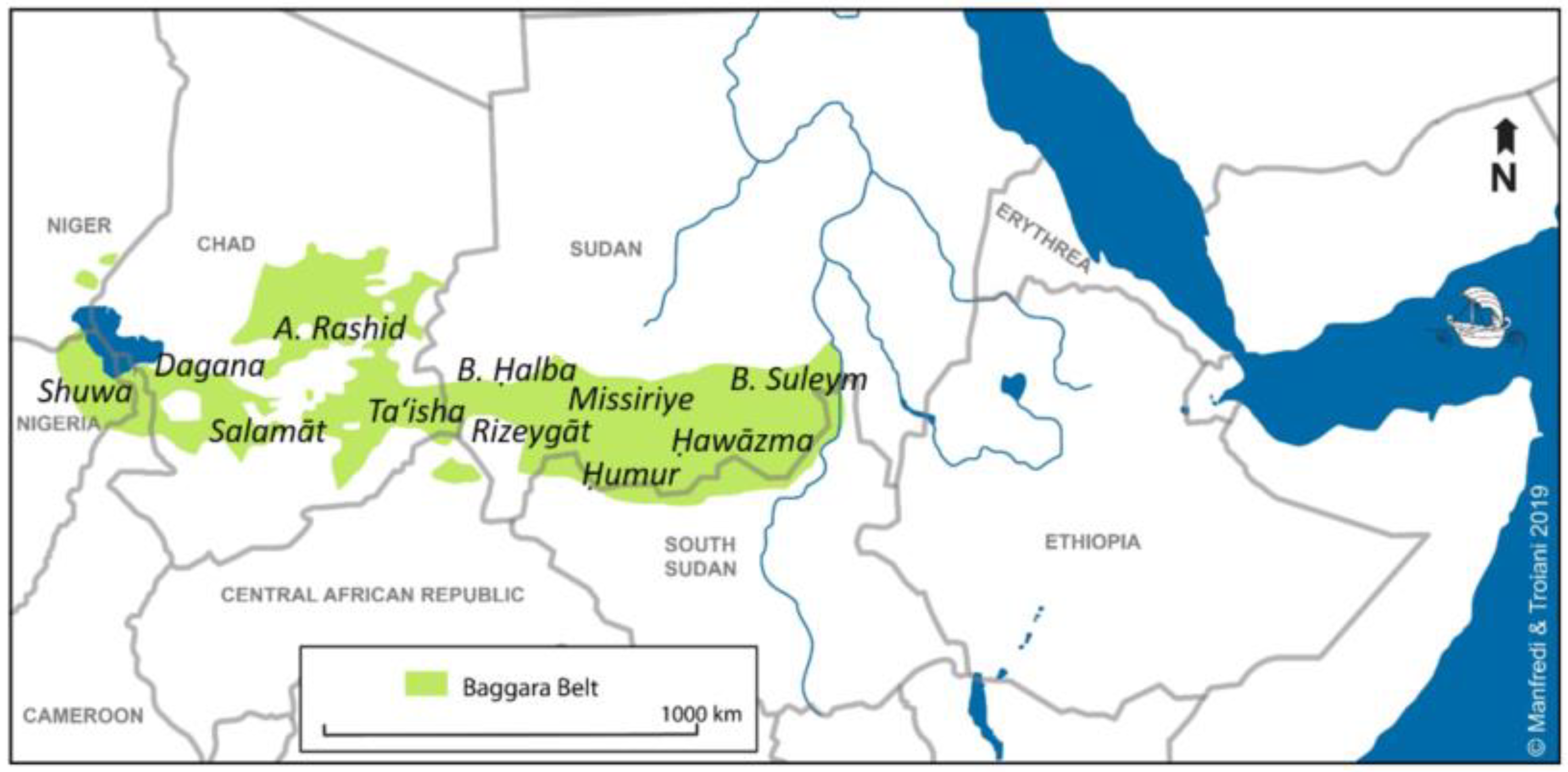
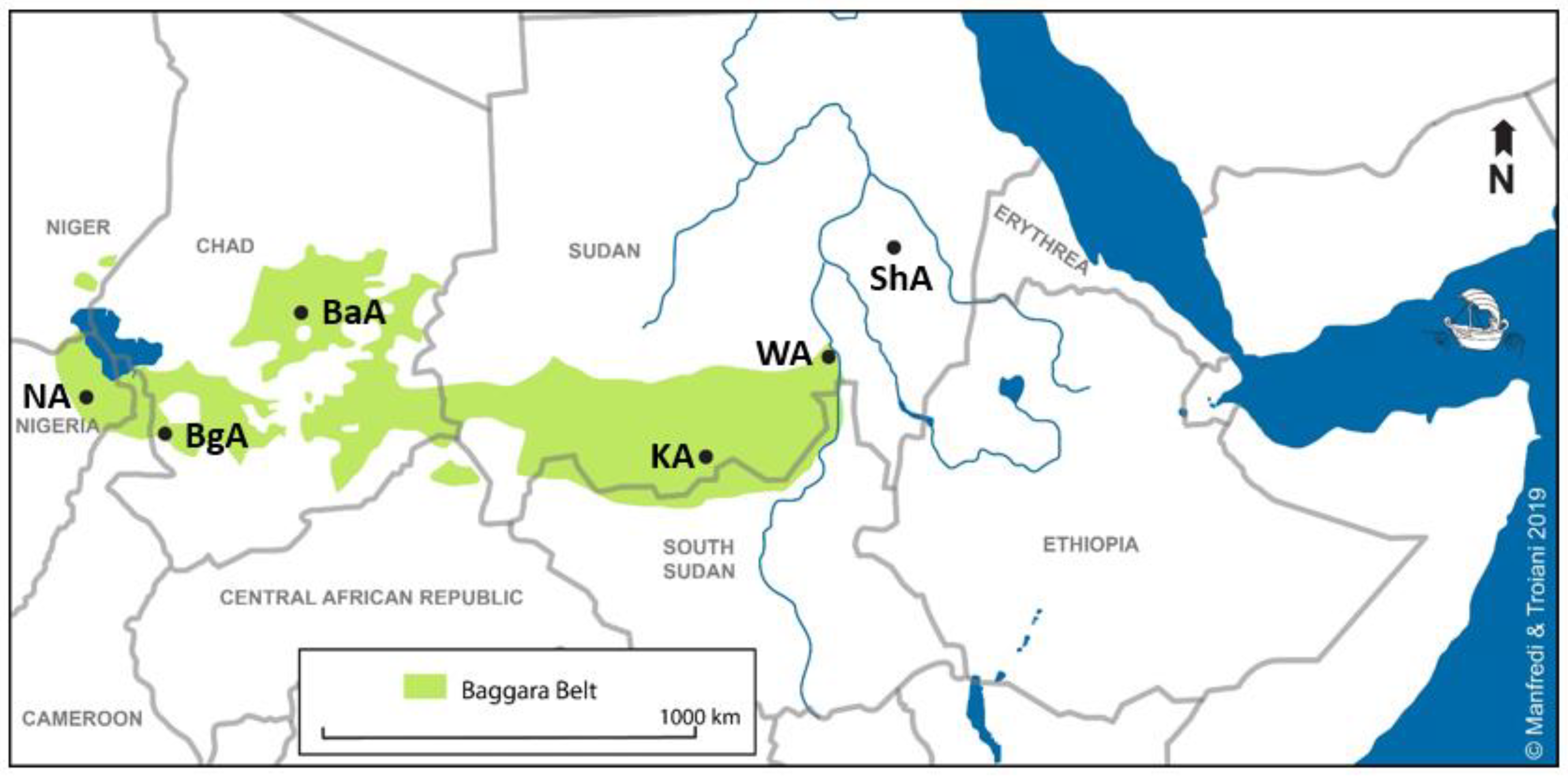
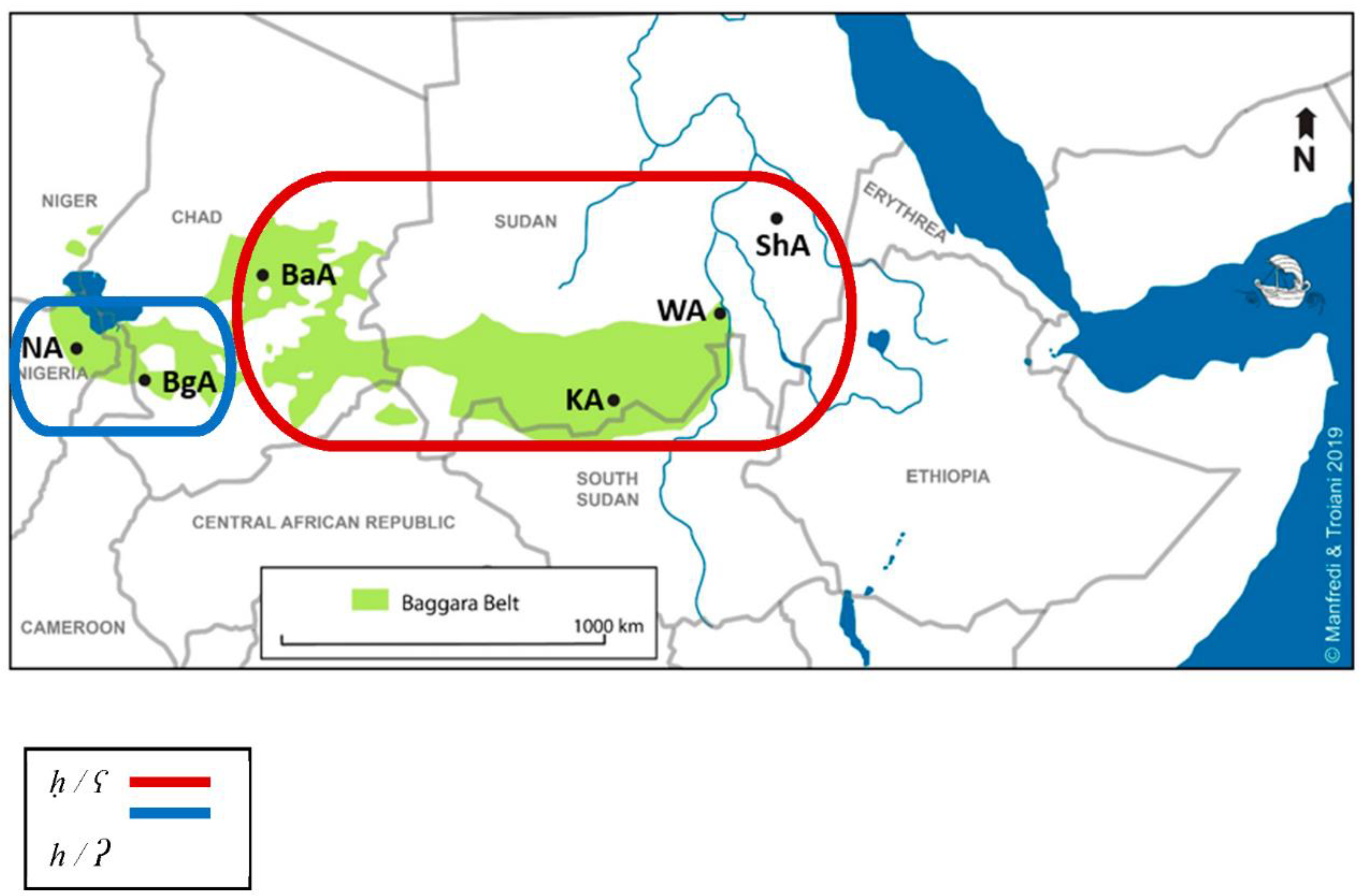
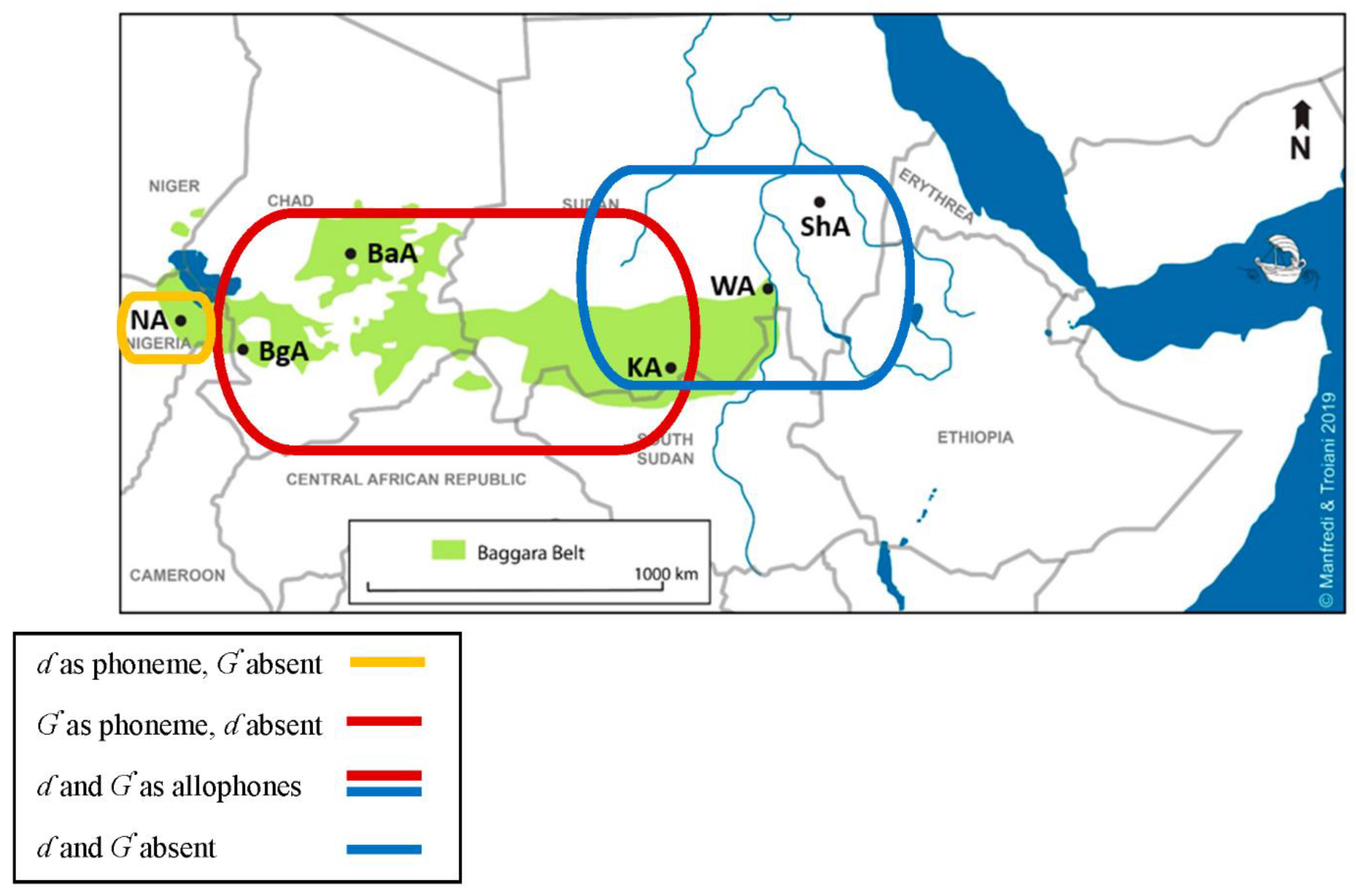
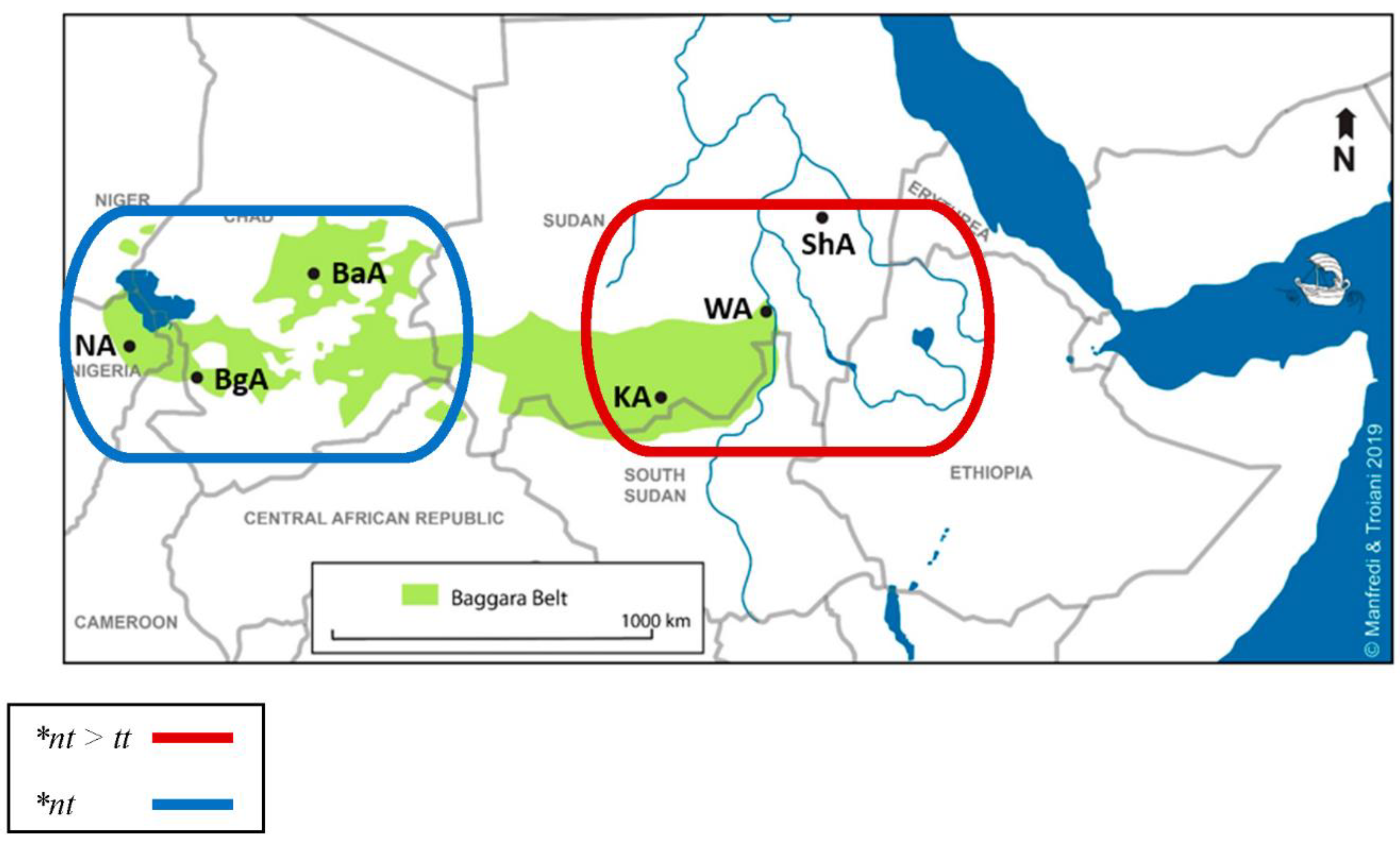
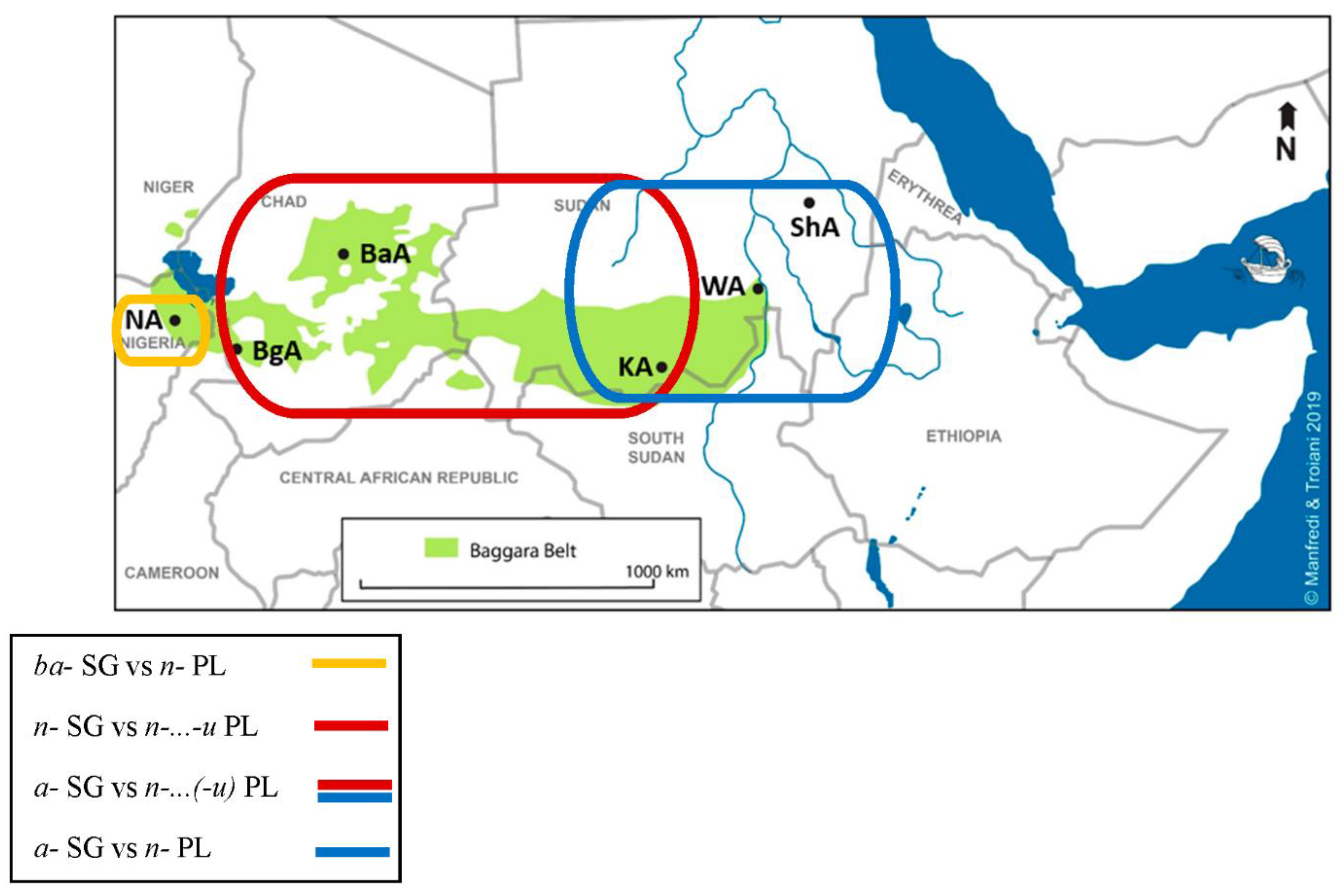
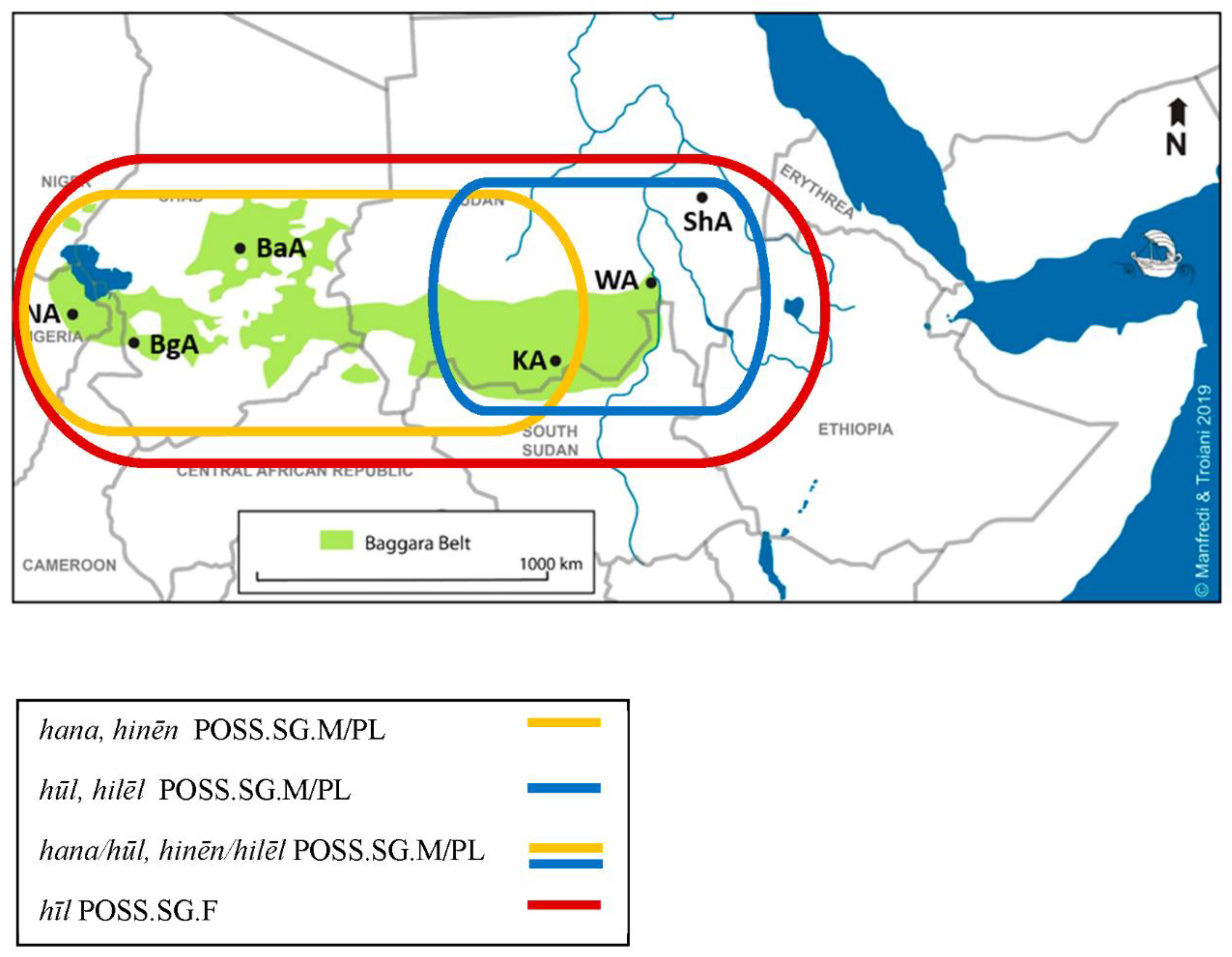
| NA, BgA, BaA | KA | WA, ShA | |
|---|---|---|---|
| 2SG.M | inta | itte | itta |
| 2SG.F | inti | itti | itti |
| 2PL.M | intu | uttu | ittu |
| 2PL.F | intan | ittan | ittan |
| katáb write\1SG | katáb-t = a write-1SG = 3SG.M |
| katáb write\2SG.M | katáb-t = a write-2SG.M = 3SG.M |
| kátab write.3SG.M | Kátab = a write.3SG.M = 3SG.M |
| NA | BgA, BaA | KA | WA, SHa | |
|---|---|---|---|---|
| CvCvC 1SG | ba-ktub | na-ktub | (b-)a-ktub | (b-)a-ktub |
| CvCvC 1PL | na-ktub | na-ktub-u | na-ktub(-u) | na-ktub |
| CvCv 1SG | ba-mši | na-mši | (b-)a-mši | (b-)a-mši |
| CvCv 1PL | na-mši | na-mš-u | na-mš-u | na-mši |
| NA | BgA | KA | WA | ShA | |
|---|---|---|---|---|---|
| POSS.SG.M | hana | hana | hān, hūl, | hūl | hūl |
| POSS.SG.F | hil, hinta | hil | hint, hīl, | hīl | hīl |
| POSS.PL | hinen | hiney | hinēn, hilēl | hilēl | hilēl |
Publisher’s Note: MDPI stays neutral with regard to jurisdictional claims in published maps and institutional affiliations. |
© 2021 by the authors. Licensee MDPI, Basel, Switzerland. This article is an open access article distributed under the terms and conditions of the Creative Commons Attribution (CC BY) license (https://creativecommons.org/licenses/by/4.0/).
Share and Cite
Manfredi, S.; Roset, C. Towards a Dialect History of the Baggara Belt. Languages 2021, 6, 146. https://doi.org/10.3390/languages6030146
Manfredi S, Roset C. Towards a Dialect History of the Baggara Belt. Languages. 2021; 6(3):146. https://doi.org/10.3390/languages6030146
Chicago/Turabian StyleManfredi, Stefano, and Caroline Roset. 2021. "Towards a Dialect History of the Baggara Belt" Languages 6, no. 3: 146. https://doi.org/10.3390/languages6030146
APA StyleManfredi, S., & Roset, C. (2021). Towards a Dialect History of the Baggara Belt. Languages, 6(3), 146. https://doi.org/10.3390/languages6030146






